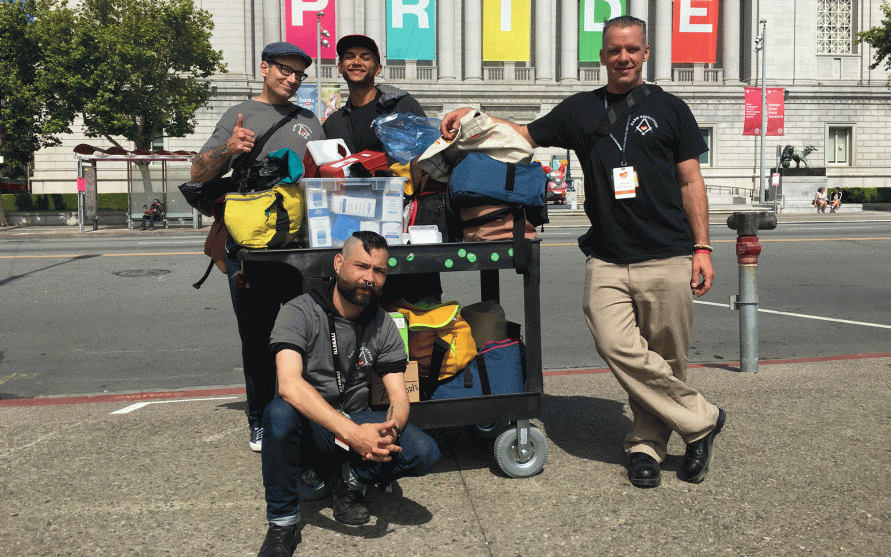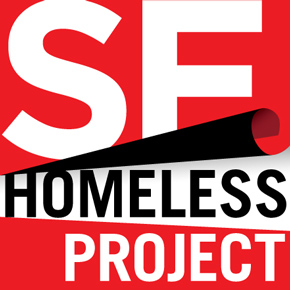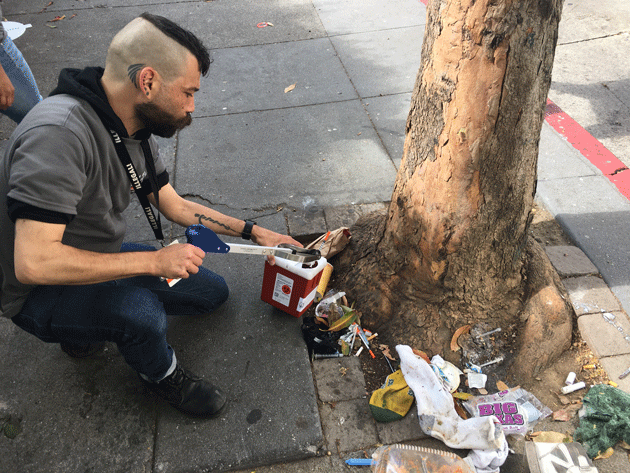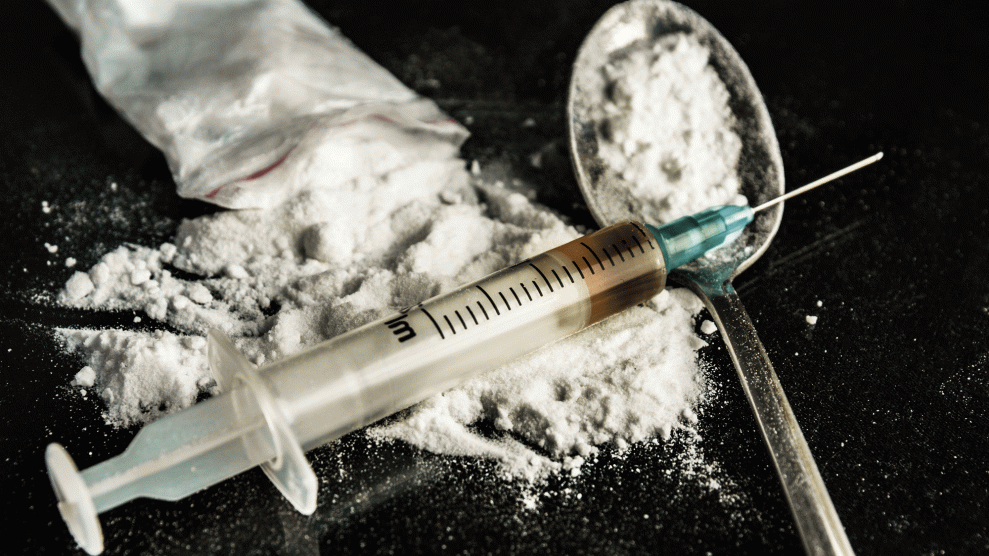
From left to right, Glide staffers Bill Buehlman, Jorge Vieto, Matthew Claveria, and Jason Norelli stand by their needle exchange cart.Julia Lurie
Standing in the square in front of the gold-leafed dome of San Francisco’s City Hall, Bill Buehlman bellows a sing-song jingle like a vendor at a baseball game: “Free harm reduction supplies! Outfits! Condoms! Brillos! Free harm reduction supplies!” He’s posted up by a rolling cart piled high with clean drug paraphernalia, from syringes and needle disposal bins to pieces of Brillo pad for filtering crack. There’s also naloxone, the drug that reverses opioid overdoses.

This article is part of the SF Homeless Project, a collaboration between nearly 70 media organizations to explore the state of homelessness in San Francisco and potential solutions.
A steady stream of mostly young, white men who appear to be homeless approach the cart asking for the “outfits” they need: “Beestingers,” short, narrow needles for new users; “longs,” for people who need to dig deeper to hit a vein; “shorts” and “28s” in between. Many are heroin users, Buehlman says, but during the nighttime outreach, clients tend to be older African Americans who skew toward crack. Some of the users walk up to the cart sheepishly. Some wave as it approaches and greet the staffers by name.
Buehlman, a tall, broad-shouldered man with tattooed arms, brims with enthusiasm for his job. “I would do this job for free if I won the lottery tomorrow,” he tells me—twice. Buehlman’s a former drug user who did time in California and Texas before making his way to Glide Memorial Church, where he coordinates outreach for HIV and hepatitis C programs. Some clients know him from the days when he was “running wild,” others know him from his years as a case manager. “I’ve either dosed at or worked at every [methadone] clinic in the city,” he says.
Glide, one of the San Francisco’s primary social service providers, operates in the Tenderloin, a 50-block stretch with San Francisco’s highest rates of homelessness and injection drug use. Half of the city’s roughly 7,500 homeless residents live in the neighborhood or in nearby South of Market. Many locals avoid the area; tourists unwittingly stumble across it on their way to hotels or cable cars. The destitution at the heart of this liberal mecca is made only more glaring by its proximity to wealth: Two blocks from where Glide staffers hand out beestingers are the shiny offices of Twitter, Square, and Uber.

Beestings, micros, and booty bumpers: Types of needles and their nicknames
Julia Lurie
Over the next couple of hours, Buehlman and three other staffers will distribute 2,840 needles, 33 safe disposal bins, and 3 naloxone refills. At the end of nearly every interaction, they remind users that they can always get more supplies from the Glide offices. And, they add tactfully, “If you know anyone who needs Hep C or HIV testing, send them our way!”
These brief exchanges are meant to get users on the path to treatment: The idea is that after hearing Buehlman’s spiel over and over, users might actually take him up on the offer of help. “Sometimes it might be 50 to 100 times we’ll see somebody” before they make their way to Glide for supplies or treatment, he says. “Sometimes, I’ll see someone once on outreach, they come in, they do a HIV and Hep C test, we link them with our navigators, a month after that, they’re like, ‘I got into residential! I’m clean, bro!’”
The program is as classic example of harm reduction, a public health philosophy that encourages making illicit drug use safer so that users survive and eventually seek treatment. Critics say that programs like needle exchanges and naloxone distribution enable drug use. “Naloxone does not truly save lives; it merely extends them until the next overdose,” wrote Maine Gov. Paul LePage last April as he vetoed a bill that would allow pharmacists to dispense the drug. But a wealth of academic research has found that these kinds of interventions stop the spread of disease and save lives. As a psychiatrist in Florida told me last year, “I can’t treat a dead patient.”
Even without any follow-up, Glide and similar programs in the city boast impressive results. Last year, users and other laypeople with no medical training used naloxone to reverse 877 overdoses—about as many as the San Francisco Fire Department, the city’s largest emergency medical provider. In 2015, San Francisco had just two documented cases of new HIV infections transmitted through dirty needles.
As Buehlman yells his jingle, a tall man named Ron with a white beard approaches the cart for some gauze and tape to cover his sores. He begins chatting with me like I’m an old friend. Ron’s 37, gay, and moved here from Florida six years ago after he relapsed on OxyContin. “I didn’t want my family to see me deteriorate and spiral down as fast as I was going,” he explains. Now, he’s addicted, infected with hep C, and homeless. When he last called the city’s non-emergency hotline to sign up for a 90-day shelter, he was number 1,398 on the waitlist.
In a different life, Ron would have been a marine biologist, or maybe a landscape architect—something that would keep him busy and creative and outside. He begins to weep. “What sucks more than anything is to know that I have so many passions and things I would love to do—and if somebody worked with me and I had a mentor and they showed me how to do it, I could learn. I could pick it up like that,” he says with a snap.

Dallas is a father figure to many younger users.
Julia Lurie
A few minutes later, I talk to a outgoing 72-year-old named Dallas who’s sitting on the sidewalk next to his suitcases. “Drugs have been in my life since I was seven years old,” he says. He’s a father figure of sorts to younger users who call this patch of the Tenderloin home, and a few say hi as they walk by. Dallas gestures to a white kid who appears to be in his late twenties and has been nodding off against a railing nearby. “A lot of these kids, they don’t have no mother or father.” The kid, whom I’ll call Todd, chimes in with his eyes still closed, “Him and a few others are all I’ve got.”
Over the past couple years, using heroin has become far more dangerous due to the arrival of fentanyl, an illicitly produced synthetic opioid that’s up to 100 times more powerful than morphine. It’s often mixed in with heroin and other drugs so that, as Todd puts it, “you don’t know what you’re doing anymore.”
With such a potent drug in circulation, some regular users often witness the blue-skinned, tight-chested trauma of overdose—or experience it first-hand. “She saved my life one time,” says Dallas, nodding to his wife Miriam, who sits nearby.
“And theirs too,” adds Miriam, nodding to a homeless couple across the street.
“In one month, we must’ve saved damn near 10 people,” says Dallas.
Later, Todd will ask Jason Norelli, a Glide staffer, for some Narcan. “How many overdoses have you witnessed?” Jason asks him. “Fifty, easy,” Todd replies. He adds, “I saw one just last night.”

“I love my job”: Jorge Vieto picks up used needles.
Julia Lurie
Before heading back to Glide, we stop by a fence where homeless residents have attached safe disposal bins. Needles still litter the block. Jorge Vieto, a cheerful HIV services navigator, uses tongs to reach for needles next to trees, in the gutters, and under parked cars. As he picks up one caked in a smelly sludge, he chants between gags, “I love my job. I love my job. I love my job.”
By 5 pm, the team is running late—meaning it has to skip a large group of drug users on the next block. “We see them on Monday and Tuesday nights—we are not trying to serve all of them.” Buehlman says. “We could be here 24/7.” Back at Glide, I ask a nagging question. I know the hard numbers support programs like this, but all of it—the needle and Narcan distribution, the syringe clean-up, the constant overdosing and reviving and overdosing again—seems like a never-ending job. What’s the end goal here?
“We are in the business of planting seeds and watering them,” Buehlman says with a grin. Countless clients who show up for Glide’s support services, from the hot meals to the addiction recovery groups to the Hep C treatment programs, report finding out about the programs through their repeated interactions with the mobile needle exchange. “We don’t know which ones are gonna sprout, when they’re gonna sprout. But here’s the fact: if we keep throwing water at them, most of them will.”













